Genre(s) Run and gun Initial release date 27 June 1986 Mode Single-player video game | Cabinet Upright | |
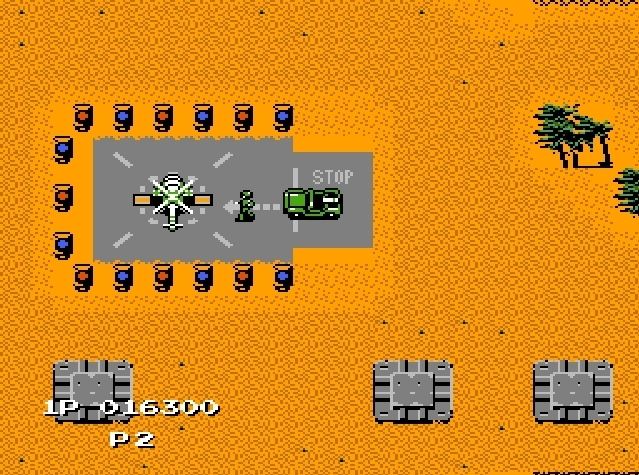 | ||
Display Raster, resolution: 224x240, 512 colors, vertical orientation Similar Rush'n Attack, Salamander, Contra, Super Contra, GunSmoke | ||
Jackal (特殊部隊ジャッカル, Tokushu Butai Jakkaru, "Special Forces Jackal"), also distributed under the title of Top Gunner, is an overhead run'n gun-style shoot-'em-up video game by Konami released for the arcades in 1986. The player must maneuver an armed jeep in order to rescue prisoners of war (POWs) trapped in enemy territory.
Contents

Plot
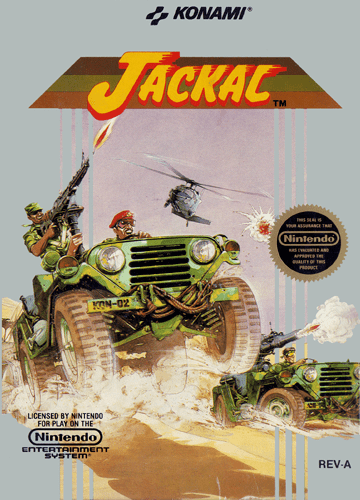
The Jackal unit is an elite group of four soldiers that have undergone a harsh training regiment to survive in any environment. The team is composed of Colonel Decker, Lieutenant Bob, Sergeant Quint and Corporal Grey. They have been given a mission to drive two armed jeeps into hostile territory in order to rescue and extract POWs.
Gameplay
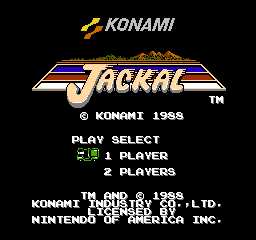
Jackal can be played by up to two players simultaneously. A second player can join in during play anytime and the two jeeps are numbered on their hoods to indicate which player is controlling it. The controls consists of an eight way joystick and two attack buttons. The first button fires the jeep's machine gun turret (which always shoots northward), while the second button is used to launch grenades towards the direction the jeep is facing. The grenade launcher can be upgraded into a missile launcher, which can be further upgraded up to three times, giving it a longer reach and then allowing it to fire shrapnel rounds that spreads in to two or four directions. The machine gun has weaker firepower but a faster firing rate, while the grenade/missile launcher can destroy most enemy vehicles and artillery in one shot, as well as destroy gates and buildings.
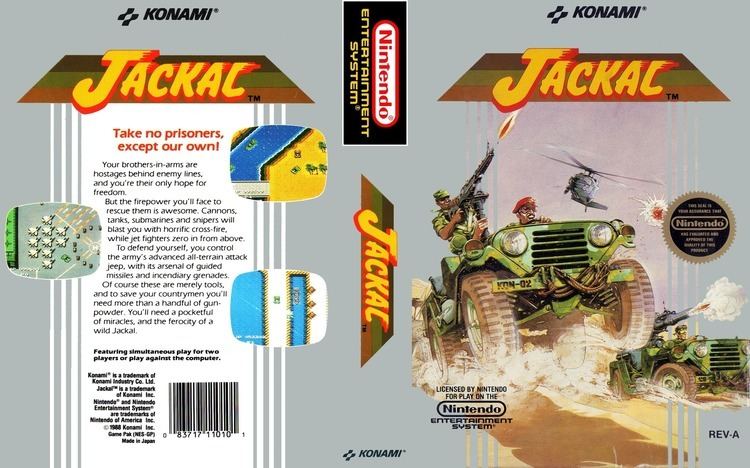
The game starts with a pair of transport helicopters dropping player's jeep into the coast of the enemy territory, followed by a plane which drops the jeep's driver and gunner. The main objective is to penetrate the enemy's main headquarters and destroy their ultimate weapon. Along the way, the player will proceed through numerous internment camps where the POWs are being held. Prisoners held in solitary camps will upgrade the jeep's grenade/missile launcher by one level. The player's jeep can only carry up to eight prisoners and once it is filled, the player must drive to the nearest heliport where an extraction chopper awaits to retrieve them. The player receives more points if he extracts prisoners in succession. If the player successfully extracts eight prisoners in a row into the chopper, the jeep's missile launcher will be upgraded to the next level. Jackal does not have a traditional stage structure, instead the entire game takes place in one long continuous level. The player will go through a variety of different areas throughout the course of the mission such as an ancient ruins, a lake, a hill and a mountain before reaching the enemy headquarters. The background music changes the further the players goes into the game.
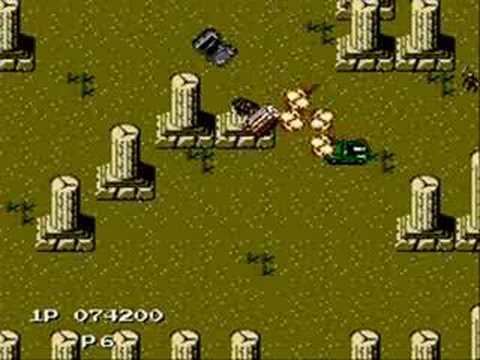
The player's jeep can run over foot soldiers, but will be destroyed if it gets shot by a projectile or collides with an enemy vehicle. When the player's jeep is destroyed, a replacement jeep will appear and the missile launcher that will be downgraded by one level. If the previous jeep was carrying POWs, the survivors will spread themselves out from the wreckage, waiting to be picked up again. An extra jeep can be obtained by obtaining a certain number of points. The game ends when the player accomplishes his mission or runs out of replacement jeeps. A map is shown at the game over screen showing how far the player has progressed. While Jackal does not have a continue feature, the player can "cheat" the game by using the join-in feature and switch to the other control panel before being taken to the game over screen.
Version differences
Jackal was originally designed to be played with rotary joysticks similar to the ones used by SNK in some of their games at the time such as TNK III and Ikari Warriors. The rotary joystick allowed the player to not only maneuver the jeep, but also control the direction of where the machine gun turret is aimed, allowing the player to shoot in any of eight directions. A version of Jackal with this control scheme was market tested, but didn't receive wide distribution. The wide releases of the game use a standard eight way joystick instead.
The game was distributed as Tokushu Butai Jackal in Japan, Top Gunner in North America and simply as Jackal in Europe, Oceania and Asia. The Japanese version of the game differs from the other releases in which the player's jeep shoots at the direction it faces instead of always shooting northward, affecting the kind of tactics that the player must employ in order to proceed through the mission. Aside from the title, the Top Gunner variant of the game is almost identical to the international version of Jackal, but has a slight cosmetic difference: the yellow and blue flags that adorned the player jeeps in Jackal have each been replaced by a U.S. flag.
NES
Jackal was released for the Nintendo Entertainment System (NES) on September 1988 in North America. Despite the fact that the arcade game was distributed in the U.S. under the title of Top Gunner, Konami decided to release the NES version under a different title to avoid confusion with their video game adaptation of Top Gun. The NES Jackal has the following differences from the arcade version.
A Japanese version was released for the Family Computer Disk System (FDS) a few months earlier on May 2, 1988 under the title of Final Command: Akai Yōsai (ファイナルコマンド 赤い要塞, "The Red Fortress"). This earlier version lacks some of the content that were later added to its NES counterpart due to the fact that it was released in disk card format rather than on a ROM cartridge. Namely, the stages in the FDS versions scrolls vertically only, have different layouts and are much shorter as a result. The beach stage is not featured in the FDS version and thus, the ruins (Stage 2 in the NES version) serves as the introductory stage instead.
Other platforms
In Europe, Konami released ports of Jackal for the ZX Spectrum, Amstrad CPC and Commodore 64 in 1988. An MS-DOS version was released in North America in 1989 alongside a different Commodore 64 port. These versions were roughly based on the arcade game. A ROM image of the NES Jackal is included in the Windows PC compilation Konami Collector's Series: Castlevania & Contra released in 2002 in North America. However, the game is inaccessible by legitimate means and can only be found by extracting it from the executable. The game is virtually identical to the original NES release, aside from the updated copyrights date.
On July 29, 2009, Konami released a mobile version of Akai Yōsai for feature phones through their Konami Net DX service. This version features the added content from the NES version of Jackal, as well as improved graphics much closer in quality to the arcade version. An unrelated mobile version of Jackal (also based on the NES game) was released by Konami for the Chinese market on August 5, 2010.
The arcade version of Jackal was released for the Game Room service on October 27, 2010.
